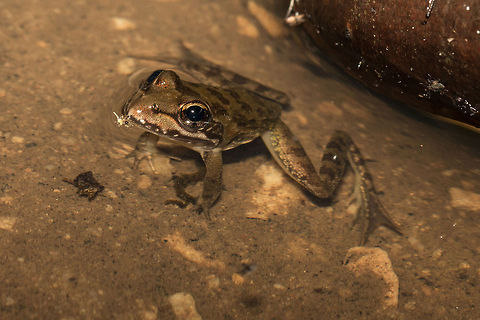
Appearance
''Amietia fuscigula'' is a fairly large, typical frog with a snout-to-vent measurement of up to about 125 mm. The snout is slightly rounded. It has a powerful, athletic build with long hind legs and feet, well adapted for leaping, but also well webbed; the species is a powerful swimmer. The fore feet are not webbed. When the animal sits at rest on a level surface, the tip of the longest rear toe reaches to directly below the tympanum.The ventral skin is smooth and white, except for dark mottling on the throat. The mottling inspired the specific epithet ''fuscigula'': Latin for "dusky throated". In some specimens, the mottling extends to the belly. The dorsal skin bears a modest sprinkling of small, rounded protuberances and segments of longitudinal ridges. The colour scheme is variable, ranging from dark- through light-brown, also commonly green or olive, or with green streaks. The back and limbs are more or less conspicuously blotched with darker irregular spots.
Little sexual dimorphism is noted, but the male in breeding season bears a dark, swollen nuptial pad on each thumb.
The eye and tympanum are prominent; the diameter of the tympanum is barely smaller than that of the eye.
Status
The Cape river frog, though locally threatened by habitat loss, for example because of dam building, is currently regarded as "least concern" because it occurs plentifully over wide areas, including in local isolated populations, and is not a specialist feeder. It also survives in altered habitats such as suitable pastureland and agricultural landLeslie Minter, Alan Channing 2004. Amietia fuscigula. In: IUCN 2011. IUCN Red List of Threatened Species. Version 2011.2. . Downloaded on 19 December 2011Habitat
The Cape river frog occurs in a wide range of temperate to tropical habitats wherever fresh water is at least sufficient seasonally for breeding, including arable land, pastureland, savanna, shrubland, ''fynbos'', grassland, rivers, swamps, freshwater lakes, marshes and springs, water storage areas, ponds, dams, and wastewater treatment areas. Sometimes they even will occupy and breed in domestic water containers such as water butts or horse troughs.References:
Some text fragments are auto parsed from Wikipedia.